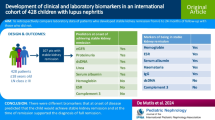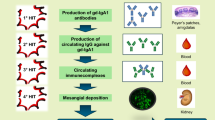Abstract
Because of some similarities in organ involvement, clinical manifestations, and histopathological features, IgG4-related disease (IgG4-RD) may occur concurrently with some clinicopathologic variants of antineutrophil cytoplasmic antibody (ANCA)-associated vasculitis (AAV). An overlap syndrome of IgG4-RD and AAV has recently been proposed in clinical and/or histopathological studies, indicating that there may be some potential pathophysiological associations between the two disease entities; however, the mechanisms underlying these are incompletely understood. Here, we describe a rare case of a 63-year-old man with IgG4-related tubulointerstitial nephritis (IgG4-TIN) and microscopic polyangiitis-associated glomerulonephritis (MPA-GN) overlap syndrome. The clinical diagnosis of MPA was based on the 2022 American College of Rheumatology (ACR)/European League Against Rheumatology (EULAR) classification criteria. Remission induction therapy with intravenous methylprednisolone was initiated, followed by oral prednisone maintenance therapy with gradual tapering. The patient remained asymptomatic and his renal function was essentially normalized within 3.5 months of follow-up. The serum IgG4 levels decreased to 5 g/L. We also conducted a literature review to identify clinical findings, treatment options, and outcomes of patients with concurrent IgG4-RD and MPA and briefly discussed the potential pathophysiological association between IgG4-RD and MPA. Our findings enrich the database of this rare overlap syndrome and provide a basis for the diagnosis and early intervention in both diseases. These results provide some insights for clinicians to recognize and treat this overlap syndrome.
Key Points • We report a unique case that enriches the database of this rare overlap syndrome and provides a basis for the outcome and early intervention in both diseases. •Several studies have suggested that IgG4-RD and MPA have a potential association, and we describe the pathophysiological mechanism of the overlap syndrome for the first time. • There have been no standardized diagnostic criteria for MPA for over 30 years; the 2022 ACR/EULAR classification criteria are expected to solve this problem. • We provide some clues for the diagnosis and treatment of this overlap syndrome based on the literature review. |



Similar content being viewed by others
Data availability
The datasets generated and/or analyzed during the current study are available upon request from the corresponding author.
References
Deshpande V, Zen Y, Chan JK et al (2012) Consensus statement on the pathology of IgG4-related disease. Mod Pathol 25:1181–1192
Kamisawa T, Zen Y, Pillai S, Stone JH (2015) IgG4-related disease. Lancet 385:1460–1471
Cortazar FB, Stone JH (2015) IgG4-related disease and the kidney. Nat Rev Nephrol 11:599–609
Jennette JC, Falk RJ, Bacon PA et al (2013) 2012 revised International Chapel Hill Consensus Conference Nomenclature of Vasculitides. Arthritis Rheum 65:1–11
Kitching AR, Anders HJ, Basu N et al (2020) ANCA-associated vasculitis. Nat Rev Dis Primers 6:71
Jarrot P-A, Kaplanski G (2016) Pathogenesis of ANCA-associated vasculitis: an update. Autoimmun Rev 15:704–713
Danlos FX, Rossi GM, Blockmans D et al (2017) Antineutrophil cytoplasmic antibody-associated vasculitides and IgG4-related disease: a new overlap syndrome. Autoimmun Rev 16:1036–1043
Li ZY, Wang X, Xia X et al (2020) An overlap of antineutrophil cytoplasmic antibody (ANCA)-associated glomerulonephritis and IgG4-related kidney disease. Clin Chim Acta 501:12–19
Kawashima H, Utsugi A, Shibamiya A et al (2019) Consideration concerning similarities and differences between ANCA-associated vasculitis and IgG-4-related diseases: case series and review of literature. Immunol Res 67:99–107
Raissian Y, Nasr SH, Larsen CP et al (2011) Diagnosis of IgG4-related tubulointerstitial nephritis. J Am Soc Nephrol 22:1343–1352
Suppiah R, Robson JC, Grayson PC et al (2022) 2022 American College of Rheumatology/European Alliance of Associations for Rheumatology classification criteria for microscopic polyangiitis. Ann Rheum Dis 81:321–326
Ohara H, Okazaki K, Tsubouchi H et al (2012) Clinical diagnostic criteria of IgG4-related sclerosing cholangitis 2012. J Hepatobiliary Pancreat Sci 19:536–542
Perugino CA, Stone JH (2020) IgG4-related disease: an update on pathophysiology and implications for clinical care. Nat Rev Rheumatol 16:702–714
Khosroshahi A, Wallace ZS, Crowe JL et al (2015) International Consensus Guidance Statement on the Management and Treatment of IgG4-Related Disease. Arthritis Rheumatol 67:1688–1699
Umehara H, Okazaki K, Masaki Y et al (2012) Comprehensive diagnostic criteria for IgG4-related disease (IgG4-RD), 2011. Mod Rheumatol 22:21–30
Della-Torre E, Lanzillotta M, Campochiaro C et al (2016) Antineutrophil cytoplasmic antibody positivity in IgG4-related disease: a case report and review of the literature. Medicine (Baltimore) 95:e4633
Alba MA, Jennette JC, Falk RJ (2018) Pathogenesis of ANCA-associated pulmonary vasculitis. Semin Respir Crit Care Med 39:413–424
Grados A, Ebbo M, Piperoglou C et al (2017) T Cell polarization toward TH2/TFH2 and TH17/TFH17 in patients with IgG4-related disease. Front Immunol 8:235
Bansal PJ, Tobin MC (2004) Neonatal microscopic polyangiitis secondary to transfer of maternal myeloperoxidase-antineutrophil cytoplasmic antibody resulting in neonatal pulmonary hemorrhage and renal involvement. Ann Allergy Asthma Immunol 93:398–401
Harper L, Radford D, Plant T et al (2001) IgG from myeloperoxidase-antineutrophil cytoplasmic antibody-positive patients stimulates greater activation of primed neutrophils than IgG from proteinase 3-antineutrophil cytosplasmic antibody-positive patients. Arthritis Rheum 44:921–930
Hussain A, Pankhurst T, Goodall M et al (2009) Chimeric IgG4 PR3-ANCA induces selective inflammatory responses from neutrophils through engagement of Fcgamma receptors. Immunology 128:236–244
Noone D, Hebert D, Licht C (2018) Pathogenesis and treatment of ANCA-associated vasculitis—a role for complement. Pediatric Nephrology (Berlin, Germany) 33
Popat RJ, Hakki S, Thakker A et al (2017) Anti-myeloperoxidase antibodies attenuate the monocyte response to LPS and shape macrophage development. JCI Insight 2:e87379
Gabillet J, Millet A, Pederzoli-Ribeil M et al (2012) Proteinase 3, the autoantigen in granulomatosis with polyangiitis, associates with calreticulin on apoptotic neutrophils, impairs macrophage phagocytosis, and promotes inflammation. J Immunol (Baltimore, Md :1950) 189:2574–2583
Millet A, Martin KR, Bonnefoy F et al (2015) Proteinase 3 on apoptotic cells disrupts immune silencing in autoimmune vasculitis. J Clin Invest 125:4107–4121
Ishiguro N, Moriyama M, Furusho K et al (2020) Activated M2 macrophages contribute to the pathogenesis of IgG4-related disease via toll-like receptor 7/interleukin-33 signaling. Arthritis Rheumatol (Hoboken, NJ) 72:166–178
Popa ER, Franssen CFM, Limburg PC et al (2002) In vitro cytokine production and proliferation of T cells From patients with anti-proteinase 3- and antimyeloperoxidase-associated vasculitis, in response to proteinase 3 and myeloperoxidase. Arthritis Rheum 46:1894–1904
Bello F (2021) The uncertain meaning of ANCA positivity in IgG4-related disease. Rheumatology (Oxford) 60:3492–3493
Shiokawa M, Kodama Y, Kuriyama K et al (2016) Pathogenicity of IgG in patients with IgG4-related disease. Gut 65:1322–1332
Capecchi R, Giannese D, Moriconi D et al (2021) Renal involvement in IgG4-related disease: from sunlight to twilight. Front Med (Lausanne) 8:635706
Wang GQ, Chen YP, Cheng H et al (2019) Antineutrophil cytoplasmic antibody and/or antiglomerular basement membrane antibody associated crescentic glomerulonephritis in combination with IgG4-related tubulointerstitial nephritis. Clin Exp Rheumatol 37:279–285
Martín-Nares E, Zuñiga-Tamayo D, Hinojosa-Azaola A (2019) Prevalence of overlap of antineutrophil cytoplasmic antibody associated vasculitis with systemic autoimmune diseases: an unrecognized example of poliautoimmunity. Clin Rheumatol 38:97–106
Acknowledgements
We appreciate the patient for agreeing to share his story in the current manuscript.
Author information
Authors and Affiliations
Contributions
Conceptualization: Ronghua He. Writing—original draft preparation: Ronghua He. Data collection: Mingqi Ma and Qiaoyan Guo. Methodology: Qiaoyan Guo and Mingqi Ma. Writing, review, and editing: Qiaoyan Guo and Ping Luo.
Corresponding author
Ethics declarations
Ethics approval and consent to participate
This study was approved by the Ethics Committee of the Second Hospital of Jilin University (No. 2018198) and adhered to the Helsinki Declaration guidelines.
Consent for publication
Written informed consent was obtained from the patient for publication of the case details and accompanying figures. A copy of the written consent is available for review by the editor of this journal.
Disclosures
None.
Additional information
Publisher's note
Springer Nature remains neutral with regard to jurisdictional claims in published maps and institutional affiliations.
Rights and permissions
Springer Nature or its licensor (e.g. a society or other partner) holds exclusive rights to this article under a publishing agreement with the author(s) or other rightsholder(s); author self-archiving of the accepted manuscript version of this article is solely governed by the terms of such publishing agreement and applicable law.
About this article
Cite this article
He, R., Ma, M., Luo, P. et al. An overlap of IgG4-related tubulointerstitial nephritis and microscopic polyangiitis-associated glomerulonephritis: a case-based review. Clin Rheumatol 42, 1459–1467 (2023). https://doi.org/10.1007/s10067-022-06493-5
Received:
Revised:
Accepted:
Published:
Issue Date:
DOI: https://doi.org/10.1007/s10067-022-06493-5




